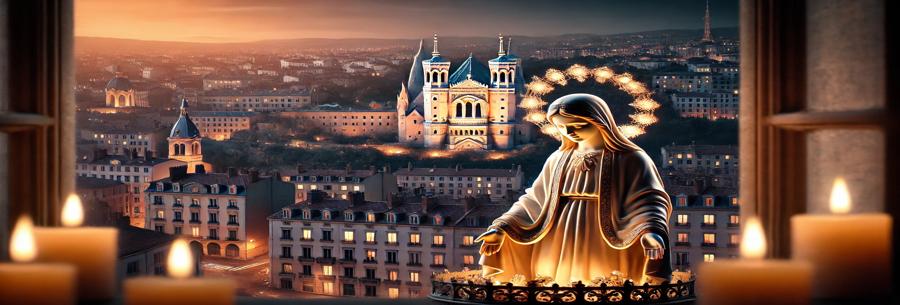From religious tradition to global event
Lyon's Festival of Lights, which illuminates the city every year in early December, is a world-renowned event. Yet behind its spectacular light projections and artistic installations lies a rich history deeply rooted in religious tradition. From its spiritual origins in the 17th century to its international influence, this festival embodies the evolution of a local celebration into a world-renowned cultural and artistic event.
The religious origins of the Fête des Lumières
The aldermen's vow in 1643:
The genesis of the Fête des Lumières dates back to 1643, when the plague was threatening Lyon. As a sign of devotion and hope, the aldermen made a vow to the Virgin Mary, promising to go up Fourvière Hill in procession every year to ask for her protection. This vow marked the beginning of a unique relationship between the town and the Virgin.
The installation of the statue of the Virgin in 1852:
In 1852, a statue of the Virgin Mary was inaugurated at the top of the bell tower of the Fourvière basilica. Initially scheduled for 8 September, the ceremony was postponed to 8 December due to bad weather. That evening, the people of Lyon spontaneously lit their windows with candles, initiating a lasting tradition of light.
An annual tribute to the Virgin:
Every year, 8 December becomes a key date for the people of Lyon. Candles were placed in windows, religious processions were organised, and the Basilica of Fourvière became the city's spiritual centre.
The transformation into a cultural event
The beginnings of artistic illumination:
In the 1980s, the city decided to amplify the scope of this festival by incorporating artistic dimensions. Historic monuments such as the Fourvière Basilica and the Place des Terreaux became the backdrops for light shows.
A growing tourist attraction:
Over the years, the Festival of Lights has attracted an ever-wider audience. Tourists from all over the world come to admire the innovative projections and immersive installations, making Lyon a must-see destination in December.
The involvement of international artists:
In the 2000s, the festival took on an international scope. Artists from a variety of backgrounds were invited to design works of light, transforming the city into an open-air art gallery.
Modern symbols and themes
Light as a universal message: light, initially a symbol of gratitude to the Virgin Mary, became a universal language. It represents peace, hope and unity in an ever-changing world.
The diversity of the creations: the light creations tackle a variety of themes, mixing spirituality, ecology, technological innovation and pure aesthetics. Interactive installations allow visitors to actively participate in the experience.
A tribute to religious roots: despite its cultural evolution, the Festival of Lights retains strong links with its origins. The tradition of candles in windows remains alive, recalling the initial act of faith of the Lyonnais.
The economic and cultural impact
A major economic event:
With more than two million visitors each year, the Fête des Lumières is an economic driver for Lyon. Hotels, restaurants and shops benefit from exceptional crowds.
An international influence:
The Fête des Lumières is now a model for other cities, inspiring similar festivals around the world. Lyon is recognised as a capital of light and artistic innovation.
Challenges and prospects for the future
Sustainability and ecology:
Faced with environmental concerns, the Fête des Lumières is adapting. The use of LED technologies and renewable energies is becoming a priority to reduce the ecological impact of the installations.
Technological innovation:
The integration of augmented reality and artificial intelligence is opening up new perspectives for even more immersive and interactive experiences.
Preserving authenticity:
While adapting to the modern era, the Festival of Lights is careful to preserve its essence: a tribute to light, whether spiritual or artistic, and a moment of communion between locals and visitors.
Lyon's Festival of Lights is much more than a festive and cultural event: it is a living history, a tradition that links past and present, a celebration that transcends borders. It embodies the evolution of a simple gesture of gratitude to the Virgin Mary into a global event recognised for its artistic brilliance and universal message. This transformation reflects not only the cultural and spiritual richness of Lyon, but also the ability of a local tradition to adapt to contemporary challenges while preserving its essence.
Each light lit, whether a candle on a windowsill or an artistic projection on a monument, carries a profound meaning. They recall the religious origins of the festival, when the people of Lyon, united in adversity, relied on the light of faith to overcome their trials. They also embody innovation and creativity, illustrating how art and technology can come together to amaze and inspire.
Today, the Festival of Lights is a universal event, a meeting place for cultures, generations and sensibilities. It attracts millions of visitors, becoming a key economic and tourism driver for Lyon. But beyond its economic impact, it offers a space for wonder and reflection, a reminder that, even in times of uncertainty, light can triumph over darkness.
The future of the festival rests on a subtle balance between tradition and modernity. Preserving its religious roots, particularly through candles and tributes to the Virgin Mary, remains essential to maintaining its authenticity. At the same time, the integration of sustainable technologies and innovative artistic creations shows that the festival continues to reinvent itself, meeting the aspirations of a global audience while respecting environmental challenges.
Thus, the Festival of Lights is much more than a light show. It is a celebration of resilience, solidarity and the human capacity to illuminate the world, not only with tangible lights, but also with universal values of hope, sharing and beauty. Every December, Lyon becomes a beacon of inspiration, reminding everyone that, no matter how dark, light always finds a way to shine.




















